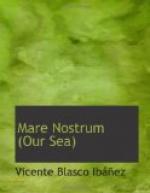The castle fell into the power of the warriors of the Church, and Manfred’s wife was conducted to a prison where her life was shortly after extinguished. Obscurity swallowed up the last remnants of the family accursed by Rome. Death was always hovering around the basilisa. They all perished—her brother Manfred, her half-brother, the poetic and lamented Encio, hero of so many songs, and her nephew, the knightly Coradino, who was to die later on under the axe of the executioner upon attempting the defense of his rights. As the Oriental empress did not represent any danger for the dynasty of Anjou, the conqueror let her follow out her destiny, as lonely and forsaken as a Shakespearian Princess.
As the widow of the late Emperor she was supposed to have a rental of three thousand besantes of fine gold. But this remote rental never arrived, and almost as a pauper she embarked with her niece, Constanza, in a ship going toward the perfumed shores of the Gulf of Valencia, where she entered the convent of Santa Barbara. In the poverty of this recently founded convent, the poor Empress lived until the following century, recalling the adventures of her melancholy destiny and seeing in imagination the palace of golden mosaics on Lake Nicaea, the gardens where “Vatacio” had wished to die under a purple tent, the gigantic walls of Constantinople, and the arches of Saint Sophia, with its hieratic galaxies of saints and crowned monarchs.
From all her journeys and glittering fortunes she had preserved but one thing—a stone—the sole baggage that accompanied her upon disembarking on the shore of Valencia. It was a fragment from Nicodemia that had miraculously sent forth water for the baptism of Santa Barbara.
The notary used to point out this rough, sacred stone inlaid in a baptismal font of Holy Water. Without ceasing to admire these historic bits of knowledge, Ulysses, nevertheless, used to receive them with a certain ingratitude.
“My godfather could explain things to me in a better way.... My godfather knows more.”
When surveying the chapel of Santa Barbara during the Mass, he used always to turn his eyes away from the funeral chest. The thought of those bones turned to dust filled him with repugnance. That Dona Constanza did not exist for him. The one who was interesting to him was the other one, a little further on who was painted in a small picture. Dona Constanza had had leprosy—an infirmity that in those days was not permitted to Empresses—so Santa Barbara had miraculously cured her devotee. In order to perpetuate this event, Santa Barbara was depicted on the canvas as a lady dressed in a full skirt and slashed sleeves, and at her feet was the basilisa in the dress of a Valencian peasant arrayed in great jewels. In vain Don Esteban affirmed that this picture had been painted centuries after the death of the Empress. The child’s imagination vaulted disdainfully over such difficulties. Just as she appeared on the canvas, Dona Constanza must have been—flaxen-haired, with great black eyes, exceedingly handsome and a little inclined to stoutness, perhaps, as was becoming to a woman accustomed to trailing robes of state and who had consented to disguise herself as a country-woman, merely because of her piety.




